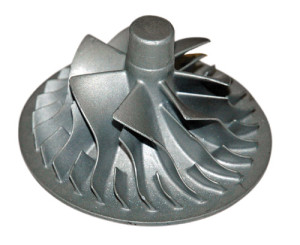Plaster Mold Casting, or PMC, also known Rubber Plaster Mold (RPM) casting, is a process that utilizes a plaster mold to create cast metal parts. The technique has its place because the tooling is less expensive than production tooling, and the part price is less than using an SLS rapid prototyped part and investment casting. PMC is considered a high volume prototyping or limited production technology.
Process
The first step is to make a mold blank using a rapid prototype process such as SLA. A cast master mold is then made by pouring two-part RTV (room temperature vulcanization) silicone around the SLA part. The cast silicone is cut on a parting line and the SLA master part is removed, creating a cavity. Each plaster mold half can then be created. These mold halves are then assembled to make a complete plaster mold that molten metal can be pour into. Silicone’s flexible nature and resistance to tearing makes the master mold suitable for producing numerous plaster molds without degradation. Silicone’s flexibility also allows for the creation of molds with undercuts and no drafting. The plaster mold is then heated and cured. While it is still hot, molten metal is poured in. After the metal has solidified, the plaster mold is broken apart, leaving the finished cast part.
Plaster has a very fine grain structure that allows for the replication of minute details such as part numbers and company logos. This means PMC parts can have details as fine as with die or investment cast parts. Plaster’s low thermal conductivity and heat capacity allows the metal to cool more slowly than in a sand casting. This means the metal can fill thin walls and complex geometry more effectively. Because of this, PMC castings can typically achieve a minimum wall thickness of .090”, which is significantly lower than with other casting methods. This fine grain structure also produces a 125-micro finish compatible with painting and oxidizing, eliminating the need for additional finishing.
Advantages
The main advantages of PMC casting versus investment or die casting are short lead time and low tooling cost. Investment and die cast parts require between 8 and 12 weeks for samples, and another 2 to 3 weeks for production parts. The PMC casting process can produce samples in 3 to 4 weeks, with only an additional 1 to 2 weeks for production parts. Some companies can produce PMC parts in as little as 2 weeks. In terms of cost, the PMC process requires a much lower upfront tooling cost than die casting and less than investment casting. The cost of tooling, when added with part costs, makes it feasible to produce as little as 10 and up to 200 parts. Once this volume is exceeded, the cost of investment casting becomes economically justifiable.
Disadvantages
The major disadvantage of the PMC process is it can only be used with materials with melt temperatures of less than 2,200 ° F (1,200 ° C). This means the process will work for aluminum, copper, magnesium, and zinc, but will not work for ferrous metals like steel. Ferrous metals will also react negatively with the sulfur present in the plaster (gypsum), making plaster casting unsuitable. It is also important to closely monitor the casting process, as the plaster mold can shrink, crack, or distort during drying, which can lead to poor surface finish or failure of the mold. The PMC process also requires long cooling times, which restricts production volumes.
Overall
Overall, though, Plaster Mold Casting’s ability to produce high accuracy, high complexity parts for minimal tooling and part costs makes it an ideal option for high volume prototyping runs.
Let Pongratz Engineering steer you in the right direction as far as what high volume prototyping is best for your part or project. We are routinely called upon to recommend and select methods for our customers. Contact us at www.pongratz-engineering.com
NEXT UP: Computer Numerical Control (CNC) Machining
Related Posts:


